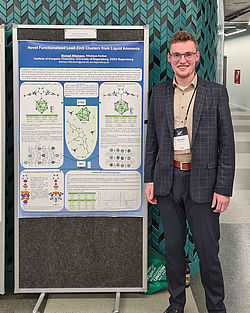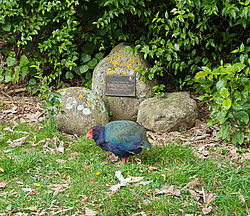Biography
Short biography
Nikolaus Korber was born in 1964. From 1984 to 1989, he studied chemistry at the university of Bonn. For his diploma thesis on sesquioxides of rubidium and caesium in the field of solid state chemistry, he joined the research group of Prof. Dr. Martin Jansen. He continued to work on his dissertation on ionic ozonides in the same group. After a one-year post-doc at the Max-Planck-Institut for solid state research in Stuttgart in the group of Prof. Dr. Dr. h.c. Hans-Georg von Schnering in 1993, he returned to Bonn to work on his habilitation on polyanions of group 15 elements, which was completed in 1998.
Since 1997, he is professor for inorganic chemistry at the university of Regensburg.
He received scholarships from the Cusanuswerk, the German National Academic Foundation (Studienstiftung des deutschen Volkes) and the endowment funds of the chemical industry of Germany. He received awards for his diploma thesis (Heinrich-Hörlein-Gedächtnispreis), his doctoral thesis (Doktoranden-Fortbildungspreis Hoechst AG, Geheimrat-Dr.-Edmund-ter-Meer-Preis) and for his post-dotoral research (Bennigsen-Foerder-Preis of North Rhine-Westphalia). In 2002, he received the Bavarian award for good teaching.
Current positions and functions:
- Vice President for Study, Teaching and Continuing Education
- Head of the center of educational studies of the university of Regensburg
- Apointee of the university for teacher training
- Member of the advisory board for the evaluation of the scholarship programme of the german Ministry for Education and Research
- Member of the science committee of the accreditation institute ACQUIN
- Member of the selection committee and the advisory board of the Cusaunswerk (scholarship body of the Catholic Church in Germany)
- Member of the scientific advisory board of the Forum of Accademia and Church
- Member of the institute for interdisciplinary research of the Goerres society
Detailed CV (PDF/36 kB)
Research
Here we have compiled comprehensive information on the research activities of the working group inorganic chemistry in liquid ammonia for you.
Reactions in water free liquid ammonia
Ammonia NH₃ is a gas at room temperature, but can be condensed by cooling below -33 °C and is then a versatile solvent. Its stability towards strongly reducing systems such as highly charged anions or even free electrons is particularly important. Many of the particles we investigate can only be solvated in ammonia, examples are Sb₅⁵⁻, As₆⁴⁻, Si₉⁴⁻ or PbSe₃⁴⁻.

Fig.1: Solutions of sodium in water free liquid ammonia showing the characteristic blue or bronze color of the generated electride solutions(left, middle). Commercially avaliable cartridge of pressurized liquid ammonia (right).
Crystallisation and characterisation of ammonia rich solvate crystals
The products often crystallize from liquid ammonia in the form of crystals with a high solvent content, known as ammoniates. These easily split off ammonia and therefore decompose at higher temperatures, often as low as -20 °C. Using a special preparation technique, it is possible to characterize these crystals when cooled and in the absence of air; the most important examination method here is X-ray structure analysis.
Cluster anions of group 14 and 15
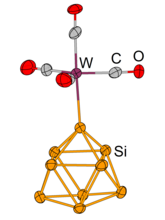
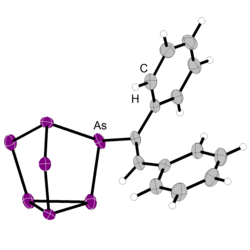
Homoatomic anions of the main group elements are popular objects of investigation in fundamental research; they can be used to study linkage patterns of the elements and fundamental aspects of non-polar chemical bonds particularly well... more
Tin-bismuthides
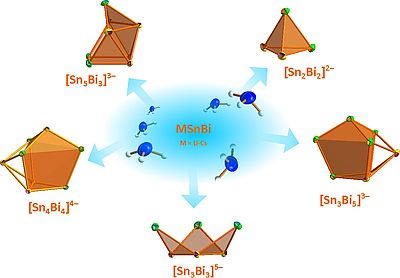
By substituting individual corners of the homoatomic clusters with heteroatoms that differ in size, electronegativity or valence electron number, the reactivities of the Zintl ions can be influenced... more
Carbonylates: strucutures, intermediates and reaktivities
Homoleptic and heteroleptic carbonyl complexes can be easily reduced directly with alkali metals in liquid ammonia. This produces negatively charged complexes, so-called metal carbonylates, which can be characterized using single-crystal X-ray structure analysis... more
An insight into the preparative methods of the working group Korber is provided in the AmmoniaNow videos in the media library of the University of Regensburg. They can be found here: https://mediathek2.uni-regensburg.de/list/688
Spacer
Teaching
Winter Semester 2024/2025
53 015
Lecture AC Main Group Chemistry
The lecture is offered for students of chemistry in the Bachelor's degree program (3rd semester) and teaching degree students at primary and middle schools (3rd semester), secondary schools (3rd semester) and high schools (3rd/5th semester). The lecture takes place in presence in H43 or H44. In addition, the entire lecture is available as a recording (as of 2020) with the material stored and linked on the Grips page.
Lecture appointments: Tue 11-12 am, H44; Thu, 11-12 am, H43; Fri, 10-11 am, H43
Link to the lecture Grips page
53 097
Practical course synthesis methods
For bachelors degree chemistry students. For the compulsory elective module "Technikum" a online registration is needed.
Dates follow
53 180
Practical research internship inorganic chemistry
For Masters students in chemistry. Dates via individual arrangement.
53 200
Seminar of the Institute of Anorganic Chemistry
For research associates and advanced students. Do 5-7 pm c.t., H46
53 401
Seminar Staatsexamensaufgaben (AC)
Dieses Semester Mo 14-16 Uhr s.t. in Präsenz im H48.
53 204
Arbeitsgruppenseminar
Für wiss. Mitarbeiter und Studierende der Chemie im Masterstudium. Mi 9-11 Uhr in CH12.0.16
53083
Vertiefungsseminar zur Veranstaltung Allgemeine Chemie - Anorganischer und Analytischer Teil
Dieses Semester vorerst in digitaler Form!
Fr 14:30-16:00 Uhr in Zoom
53082
Übungen zur Veranstaltung Allgemeine Chemie - Anorganischer und Analytischer Teil
Einteilung in Gruppen. Termine und Raum entnehmen Sie bitte Ihrer Gruppennummer im EXA.
53 103
Analytical Methods of Inorganic Chemistry
Der Kurs findet dieses Semester vom 09.10.-13.10.2023 von 9-16 Uhr im H46 statt.
What's new?
The first Seminar on Chemical Crystallography
From 23.09. to 26.09.24 the first seminar for chemical crystallography took place in Regensburg. Paul Braun and Michael Witzmann each gave a talk in which they reported on problems in their crystal structures. Michael was also able to chair one of the lecture sessions. In discussions with other doctoral students, they were able to share their experiences in the field of chemical crystallography. In addition, the numerous applications of the programs in the CSD software catalog were explored in depth during a CSD workshop. To break up the scientific program, a city tour through the historic old town of Regensburg took place.
GDCh Conference on Inorganic Chemistry
From 16.09. to 18.09.24 the GDCh Conference for Inorganic Chemistry took place in Munich. It is a conference of the Division for Solid State Chemistry & Materials Research and the Wöhler Association for Inorganic Chemistry. Together with AG Gärtner, Paul Braun and Michael Witzmann presented their new results on Zintl chemistry in liquid ammonia. In addition to the numerous interesting lectures in the field of inorganic chemistry, new ideas were also shared in discussions with doctoral students working on related topics. The entertainment program in Munich was not neglected either, which was concluded with a conference dinner in the Augustiner Stammhaus.
Link to Paul's poster; Link to Michael's poster
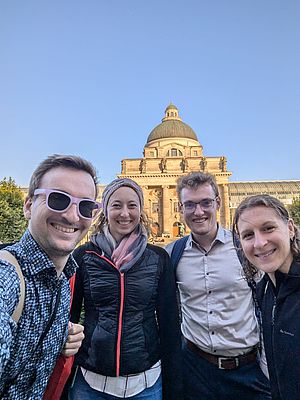
3rd place at the ChemSlam for Franz Schmidt
On the "Day of Chemistry" on 18.07.2024 a ChemSlam was held for the first time. Franz was able to take 3rd place with his presentation on "Ammonia - not just for dyeing hair".
7. GRK Report Retreat in the Prostestant Academy in Tutzing
From 27.06. to 28.06.24 the 7th GRK Report Retreat took place in Tutzing at the Protestant Academy, in which Franz Schmidt and Paul Braun participated. Over two days, the current results of GRK 2620 “Ion-Pairs in Re-Action” were presented and discussed in plenary. In addition to exciting presentations, this time there was also a poster session for all PhD students. Franz was awarded one of three poster prizes, worth 50 €, for his poster on “Carbonylates: Structures, Intermediates and Reactivities”.
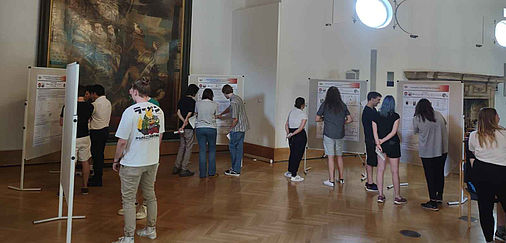
The 20th International Symposium on Silicon Chemistry
The ISOS-20 took place in Hiroshima (Japan) from May 12 to May 17. Paul Braun presented his results on the functionalization of Zintl silicon clusters. The conference offered the opportunity for an exciting exchange about Zintl chemistry with other scientists. The discussions were deepened at a joint dinner with Prof. Fässler's working group in the Hondori food district. However, Zintl chemistry was not the only topic of discussion; there were also interesting insights into other facets of silicon chemistry. The event was rounded off with an excursion to a World Heritage Site, the Itsukushima Shrine, on the island of Miyajima, a matcha tea ceremony, a traditional kagura dance and a conference dinner at the ANA Crowne Plaza Hotel. This research trip was made possible by funding from RTG 2620 “Ion Pair Effects in Molecular Reactivity”. Pauls poster
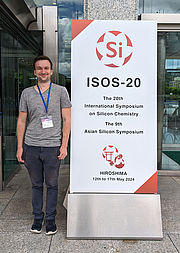
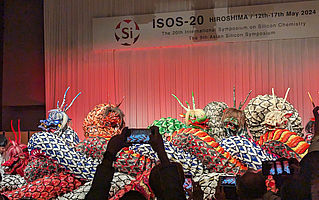
17. International Conference on the Coordination and Organometallic Chemistry of Germanium, Tin and Lead in Wellington (New Zealand)
From 27.08.-01.09.23, the 17th GTL conference took place in Wellington (New Zealand), which Michael Witzmann attended. For five days, there were exciting presentations on current research findings relating to the elements germanium, tin and lead. He was also able to exchange ideas and problems in research with international experts in this field and make new contacts worldwide. Of course, the breathtaking nature of New Zealand was not neglected either, which could be admired during an excursion to Zealandia Te Māra a Tāne Wildlife Santuary. Finally, Michael was awarded one of three poster prizes, worth $300 NZD, for his poster on “Novel Functionalized Zintl Clusters from Liquid Ammonia”.
